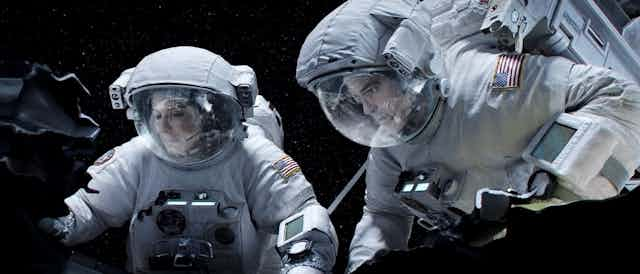Gravity has been nominated for ten Oscars, and sauntered away from the BAFTAS with a controversial Outstanding British Film award under its belt too (much of it was shot in the UK, yes, but the stars shining down onto it brought their light from awfully far away). So the possibility that a megabudget 3D science fiction film might win Best Picture isn’t out of this world. This has prompted much excitement from various quarters. Science fiction at the Oscars? About time, they say.
Is it a science fiction film, though? It’s not set in the near future, not that I could glean. Though rarefied, the technology on display is seemingly extant – there isn’t a hoverboard in sight. Aside from the what-has-to-be-extraterrestrially-sourced anti-ageing technology favoured by its lead performers, there isn’t any discernible alien influence. And if the conspiracy theorists are to be dismissed, then we’ve travelled much further than the distance from Earth that is represented here.
Gravity’s about a maintenance job, really, one that’s quotidian for at least one of its characters, but which goes awry due to adverse weather conditions and becomes a hell of a lot harder to maintain. The disaster that follows could happen, yes, but not in a way that portends disaster if humanity fail to change its ways, a lá Metropolis or Blade Runner. Gravity’s about as fantastical as Apollo 13 when it reminds us that sometimes even Houston has problems.
So the film is not necessarily categorisable as a sci-fi. Perhaps this is what has made it so popular on the awards circuit. The film is perhaps, then, more pertinently legible as a survival thriller. Films such as Alive, The Grey and Deliverance concern “everyman” characters facing extraordinary situations beyond the frontier, and there seems to have been a concession this year that a final frontier is a frontier nevertheless.
What these films have in common is that they not only tell of surviving, but also interrogate its purpose. The question Dr Ryan Stone and the spectator are prompted to ask is not whether or not she will be able to endure – but whether or not there’s any point in bothering to even try.
It’s eventually decided it’s worth the trouble. In light of this, the tagline, “Don’t Let Go”, requires a double take. Rather than specifically functioning as vocational advice for would-be astronauts, it’s a more general, humanist admonishment to not let your grip slip on life. So the film’s thriller dynamics dovetail with its existentialism in complementary ways, and it’s this that makes the film such an accomplished work.
It’s one of the most germane uses of 3D yet, too. Though the technology has so often been derided as a gimmick, it provides nuances that a “flat” film would find rather difficult. Because 3D can activate a sense of distance from the objects represented, the act of reaching for things and trying to not let go becomes much more vivid.

In order to appreciate what 3D brings to the film, consider the number of shots where Earth occupies the background of the image. It’s huge, often occupying the majority of the frame. If you’re lucky enough to be seeing it in IMAX, then it towers above you. With Stone and Kowalski so far from home, its presence in the background of many shots functions as a visual tease, snidely poking its nose in to taunt us throughout the gravitationally unmoored tracking shots that are hard enough to bear as it is. 3D adds to this frustration, aligning us with the character in that it’s able to push the planet deep back, far away from both characters and viewers. No matter that the planet fills the frame: it feels so far away.
That said, I don’t think that the film will take the big prizes, nor that it should. Also up for the Best Picture award this year is 12 Years a Slave. This is a film also concerned with survival, and it similarly deploys an endurance aesthetic often reliant on long takes to generate discomfiture. But the viewer’s experience in this case serves a purpose with much more gravitas, concerning as it does issues that are much closer to home.
Yes, Gravity is a spectacular feat, and it’s an indicator that 3D has come into its own. In any other year, its powerful and human story, admirably told through and augmented by the latest technology, would merit its walking away with Best Picture as well as the technical awards that it will surely win. But this just isn’t one of those years – the story of 12 Years a Slave is one that needed telling more.

